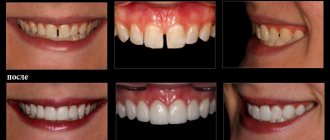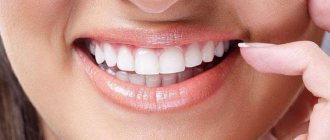Nowadays, there are many ways to restore and restore teeth. The essence of this particular method is that with its help the doctor can extremely accurately adjust the required proportions of the composite material in the missing areas of the damaged unit. This system is most often practiced on central and lateral incisors. Allows you to control the desired thickness of the layers of applied material and thereby achieve maximum anatomical similarity of the tooth outline. The active ingredient is silicone.
First, an impression of the damaged area is taken, including adjacent teeth. The key is then cut along the leading line of the sharp edge and applied to the unit being restored, applying a composite compound that approximates the shade of the enamel.
Features of the silicone key method in dentistry
The development of modern restoration methods makes it possible to functionally and aesthetically restore teeth.
One such method is the technology of using a silicone key. A silicone key in dentistry is a technique for restoring the anatomical shape of teeth using silicone impressions. These keys are made using a plaster model. The defect is restored with wax. An occlusal silicone key is used to accurately follow the anatomical shape. This is especially true for the palatal surface. The template is used for the restoration of both frontal and lateral molars. To obtain the most reliable copy, the template must cover the gum area and adjacent teeth.
The template is made from A-silicone directly in the oral cavity, an impression is taken, and the cutting edge of the tooth being restored and two adjacent ones on opposite sides are captured for reliable support. The resulting impression is cut along the line formed by the cutting edge.
Price
Pricing policies vary and depend on many factors. Raw materials, technological equipment, and the level of personnel qualifications affect the price level for dental restoration using the occlusal key method. Private clinics will offer patients a high-quality level of service, but prices will be higher than when visiting public clinics.
The cost also depends on the number of units restored. You can find out all the information about the price lists for the services provided directly by visiting the websites or by calling medical institutions.
Dental restoration using the silicone key technique is an invasive technology. This technique allows you to restore the functionality of teeth with minimal time.
Teeth treated and restored in this way do not differ from real ones and serve for a long time. Aesthetic restoration allows you to correct defects, shape, color, etc. The patient spends less time compared to traditional methods of dental restoration.
Features of restoration
The silicone key method in therapeutic dentistry is an innovative development that allows for maximum aesthetic appearance and anatomical shape of the tooth being restored. This technique significantly reduces the time required for restoration.
This technology is also used to eliminate hidden forms of caries characteristic of molars of the chewing group. The carious cavity is filled with composite material, and the final portion is modeled with a template. At the same time, to eliminate the influx of material, outlet channels are created in the key.
The impression can be made without using a spoon. The restoration procedure can be performed in several stages with layer-by-layer application of the material. Instructions for using a silicone key in dentistry can be seen in the video.
ENDODONTICS
| Application anesthesia | 200 RUR |
| Injection anesthesia | 600 rub. |
| Mechanical, medicinal and ultrasonic treatment of a 1-channel tooth | 1,700 rub. |
| Mechanical, medicinal and ultrasonic treatment of a 2-channel tooth | RUR 2,100 |
| Mechanical, medicinal and ultrasonic treatment of a 3-channel tooth | RUB 3,100 |
| Mechanical, medicinal and ultrasonic treatment of a 4-channel tooth | RUB 3,600 |
| Mechanical, medicinal and ultrasonic treatment of a 1-channel tooth during retrograde filling | RUR 2,100 |
| Filling a 1-canal tooth (using gutta-percha condensation method) | 1,700 rub. |
| Filling a 2-channel tooth (using gutta-percha condensation method) | RUR 2,100 |
| Filling a 3-channel tooth (using gutta-percha condensation method) | RUB 3,100 |
| Filling a 4-channel tooth (using gutta-percha condensation method) | RUB 3,600 |
| Retrograde root canal filling | 1,500 rub. |
| Unsealing 1 root canal filled with gutta-percha | 1,600 rub. |
| Unsealing 1 root canal filled with cement | RUR 2,100 |
| Unsealing of 1 root canal filled with the “resorcinol-formalin” method | RUB 2,600 |
| Removal of a foreign body from the root canal (fragment of a broken instrument, anchor pin, stump tab) | 2,300 rub. |
| Temporary filling of canals with anti-inflammatory drugs during endodontic treatment (1 channel) | 700 rub. |
| Insertion of a Ca-based drug into the channel | 700 rub. |
| Insertion of Metapex into the channel | 700 rub. |
| Tooth restoration after endodontic treatment, class 1 | RUR 2,500 |
| Tooth restoration after endodontic treatment, class 2 | RUR 2,800 |
| Tooth restoration after endodontic treatment, class 3 | RUB 2,900 |
| Tooth restoration after endodontic treatment, class 4 | RUB 3,800 |
| Tooth restoration after endodontic treatment, class 5 | 2,300 rub. |
| Temporary restoration of the tooth wall during endodontic treatment | 500 rub. |
| Application of fiberglass pin | 1,200 rub. |
| Applying a temporary filling | 300 rub. |
| Application of a light-curing temporary filling | 500 rub. |
| Control inspection | 0 rub. |
Make an appointment
Indications and contraindications
Indications for the use of a silicone key are the following patient conditions:
- recovery from injuries in the form of chips;
- the need to replace old fillings;
- treatment of caries in the primary stages;
- need for aesthetic restoration.
Since silicone group materials are used, some patients may experience allergic reactions to them. Such cases are contraindications for the use of silicone template technology.
Types of rubber dam.
Classic rubber dam.
This is a latex napkin, which in turn varies in density and thickness. Depending on the purpose, a certain type is used. There are also differences in colors that determine the scope of application. The colors are: light beige, blue, pink, green, gray, blue.
Liquid rubber dam.
Made on a gel basis, when used it tends to be distributed evenly and is fixed when exposed to special light. This type of rubber dam is used for teeth whitening, sometimes in combination with endodontics (canal treatment).
Free consultation
Startsmile experts are leading dentists in Moscow. Doctors at our aesthetic dentistry center SDent are among the leading specialists in the field of dentistry throughout Moscow.
More details
SDent in the TOP 10 best dental clinics in Moscow A place of honor in the 2021 rating of private dental clinics in Moscow by the expert magazine about dentistry Startsmile with the support of Kommersant Publishing House
More details
AT THE GERMAN AESTHETIC DENTISTRY CENTER ES-DENT, specialists provide a guarantee for dental treatment and are responsible for the long-term quality result, ensuring the most comfortable condition of the patient during the treatment procedures. That is why the use of a rubber dam has positive aspects for both the patient and the doctor.
Advantages and disadvantages of technology
Silicone template (key) technology allows you to achieve the following results:
- significant savings in recovery time;
- the palatal surface optimally matches the natural one, the occlusal plane is almost natural and suits the patient (at the final stage of restoration, some adjustment is required at the points of closure of the teeth);
- absolute symmetry along the contour between the cutting edges of the canines and incisors;
- controllability of the process of applying composite materials and, as a result, optimal thickness, requiring minimal finishing.
Not without certain shortcomings. These include the following factors:
- silicone is a hard material, which does not make it possible to fully display micro anatomy;
- silicone is subject to deformation when composite materials are pressed;
- work is limited to a single-pack execution technique;
- the use of latex fabric makes it difficult to work with the silicone block.
Recent developments use a carrier (applicator) and fluid composite materials, which allows you to get as close as possible to the anatomical structure when taking impressions.
Composite veneers
Restoring the front teeth with composite veneers also has its advantages:
- Low cost in comparison with ceramic veneers (achieved through the use of inexpensive materials and the simplicity of the technology used).
- Possibility of restoring a damaged tooth in one visit (no need to waste time making impressions and veneers in the laboratory).
- They successfully cope with the task of masking chips, unevenness, and cracks.
The disadvantages include an insufficiently tight fit to the tooth surface and an imitation of natural color that is not as ideal as ceramic veneers.
Stages of dental restoration
Teeth restoration using silicone template technology is performed in the following sequence:
- Definition of color . At the first stage, it is necessary to decide on the color of the incisor or molar to be restored.
- Shape modeling . Wax is used and the shape of the tooth is repeated on the model. The extracted model serves as the basis for making a silicone template. This technique is called Wax-up by dentists.
- Mock-up . Direct modeling of the anatomical shape of teeth in the oral cavity.
- Making a key . The taken silicone impression serves as the basis for making a silicone template of the palate surface.
- Preparation . When using the Mock-up technique, composite materials are first removed from the oral cavity, then grinding (preparation) of the cavity with caries is performed. If necessary, for the purpose of aesthetic restoration, pigment tissue is removed from the enamel surface. To ensure a smooth color transition between artificial and natural tissues, the dentist creates a bevel of the enamel surface.
- Cleaning . Using abrasive pastes and special tools (brush attachment), teeth are cleaned.
- Etching . For etching and application of adhesive material, it is necessary to ensure reliable protection of teeth from contact with saliva secretions.
- Securing the key . A composite material of the desired shade is applied to the silicone matrix (cutting edge). The finished silicone template is fixed on the tooth surface from the palatal side. Then a base tint enamel is applied. The process is performed from the palatal surface. Thus, the template sets the shape for further application of the composite in several layers.
- Applying the base shade of enamel . To form the dental approximal surface, it is necessary to install a special matrix. After this, the dentist applies a base shade of enamel.
- Application of dentin . At the next stage, layer-by-layer application of the dentin surface occurs. The restoration is performed in the direction from the oral to the vestibular surface.
- Overlaying color . Applying the required enamel color tone completes the restoration stage.
- Hardening and cleaning . The resulting enamel is dried until hardened and then mechanically cleaned.
- Polishing . At the final stage, the restored surface is polished using special silicone nozzles at low speeds.
As a result, after all the manipulations, the patient has a restored incisor that is practically no different in anatomy and color.
Important: materials for fissure sealing
Materials for fissure sealing are divided into 3 groups: composite (chemical or light curing), glass ionomer cement and compomer. What is the difference between them...
- Composite materials - These materials are made from a special composite resin and can be cured either by light or chemically. Materials of this class are divided into 2 subgroups: unfilled and filled sealants. The former have high fluidity, and therefore penetrate even the narrowest and deepest fissures; in addition, they adhere more tightly to the enamel surface, but wear out faster and require replacement.
Filled sealants have less fluidity and penetration depth, and therefore they are more often used for invasive fissure sealing technology (see below). Their disadvantage is also their high sensitivity to moisture and complex application technology. Pros: high abrasion resistance.
Important: this class of materials allows you to protect your teeth from fissure caries for a long time (up to 5-8 years). The degree of preservation of the composite sealant 3 years after application is up to 90%. The best composite sealants include the following 3rd generation light-curing sealants: “Fissurit”, “Helioseal”, “Estisial LC” and especially those containing fluorine – “Fissurit F” and “Admira Seal”. The release of fluoride from Fissurit F continues for more than 190 days from the moment of application!
- Glass ionomer cements (GIC)– these materials have a pronounced cariesstatic effect due to the presence of aluminum, zinc, calcium, and especially due to the fluorine content. These materials are chemically cured; a big plus is that they do not require etching of the enamel with 38% acid before application (unlike composite materials).
Compared to composite materials, GICs have low fluidity, which does not allow their use in deep fissures without opening them with a drill, and also have a greater degree of edge leakage and wear out faster. There is an opinion that the use of GIC as fissure sealants is justified when it comes exclusively to newly erupted teeth (with extremely low mineralization of fissure enamel). In the latter case, it is not advisable to etch the enamel with acid, and for the use of composites, the enamel must always be etched.
The safety of GIC 1, 6, 12 and 24 months after application is 90, 80, 60 and 20%, respectively, and after 3 years it is only 10% (in turn, the composite sealant is 90%). However, this class of materials reduces the occurrence of caries in fissures by 80-90% in 2 years. The following materials belong to GIC: “Dyract seal”, “Fuji”, “Glass Ionomer”, “Aqua Ionoseal”...
- Compomers - they are classified as light-hardening composite materials, however, components have been added to their composition that give them the positive properties of glass ionomer cements.
Advantages compared to traditional composites: greater tolerance to humid environments, greater fluidity and the ability to release fluoride in small quantities. It should be noted that these advantages had to be paid for with a greater degree of abrasion (in 2 years the compomer almost completely disappears). Materials of this class include “Dyrect Seal” (Dentsply).
The effectiveness of sealants: conclusions
Comparative results of a study of different methods of caries prevention showed that the method of sealing dental fissures is the most effective. Patients who had their fissures sealed experienced a 92.5% reduction in caries growth during the first year compared to patients who did not have their fissures sealed. For example, if caries prevention is carried out only by treating teeth with fluoride-containing varnish (once a year), this reduces the increase in caries only to 70%.
A one-time sealing of dental fissures is guaranteed to be effective for an average of up to 5 years, but can retain its properties for up to 10 years (this also occurs by increasing the resistance of fissure enamel to caries due to the release of fluoride ions by the material). Research shows that after 7 years of fissure sealing with composite materials, about 49% of fissures are still sealed.
The best material: the most effective materials are undoubtedly composites, but when it comes to sealing fissures in newly erupted teeth (the enamel of which has extremely weak mineralization), then preference should be given to glass ionomer cement. Also, preference should be given to glass ionomer cements when sealing fissures in children with little contact, for whom it is difficult to achieve good isolation of the tooth surface from saliva. We hope that our article on the topic: Fissure sealing in children, pros and cons, was useful to you!
Sources:
1. The author’s higher professional education in dentistry, 2. Personal experience as a dentist, 3. The European Academy of Pediatric Dentistry (USA), 4. National Library of Medicine (USA), 5. “Pediatric therapeutic dentistry. National leadership" (Leontyev V.).
Method of dental restoration with composites using a silicone template
Method of dental restoration with composites using a silicone template
Silicone template
(silicone, occlusal key) is necessary to accurately reproduce the anatomical shape of the tooth, especially the palatal surface. Used for restorations of upper incisors. It is made from ordinary A-silicone, directly in the oral cavity, an impression is taken from the teeth being restored (possibly without a spoon), capturing the cutting edge of the tooth being restored and one adjacent tooth at a time for support. The cast is cut along the line formed by the cutting edge.
Stages of tooth restoration using a silicone template:
1. Determination of the color of hard tooth tissues.
2. Direct (mock-up) or indirect (wax-up) modeling of the tooth shape.
Wax-up technique
(reproducing the shape of teeth on a model using wax) with mandatory checking of occlusal relationships. Based on the Wax-up, a silicone key is made, which allows you to reproduce the palatal surface of the teeth in accordance with the occlusion.
Mock-up technique
(English life-size model) is a technique for modeling the anatomical shape of a tooth directly in the patient’s oral cavity. It is carried out to determine the optimal shape, taking into account the need to increase their size and reduce the width of the interdental spaces. It is recommended to apply a composite material that is a different color from the original tooth color. It is necessary to pay special attention to modeling the shape of the palatal surface, without which it is impossible to make an appropriate cast.
3.
Taking a palatal silicone impression and making a silicone template for the palatal surface of the restoration. If the tooth has previously been restored, then this stage is carried out before removing the existing restoration.
4.
Removing the restoration and composite materials that were used for the mock-up procedure. Preparation of a carious cavity. According to aesthetic requirements, pigmented tissues are removed. A bevel is formed on the vestibular enamel surface for an imperceptible color transition from the restoration material to the tooth tissue.
5.
Cleaning teeth using rotating brushes and abrasive pastes.
6.
Repeated determination of the color of hard tooth tissues.
7.
Isolation of the tooth from saliva, etching, application of adhesive.
8.
An enamel-colored composite is applied to the area of the cutting edge of the silicone matrix. The prepared silicone template is fixed on the palatal surface of the tooth. A base layer of enamel shade is created first on the palatal surface. Thus, the palatal template provides the basis for the application of subsequent layers of composite material.
9.
To form the approximal surface of the tooth, a matrix is installed using wedges and the base shade of enamel is applied.
10.
A dentin shade is applied in layers to the formed palatal surface. The structure of the tooth is restored sequentially from the oral surface to the vestibular one. At this stage, the formation of specific anatomical details, for example, mamelons* begins.
11.
The restoration is completed by applying an enamel shade that has the same tone as the palatal and proximal layers.
12
. The final mechanical treatment is carried out after the restoration surface has dried. Without insulation, due to the effect of enlarging an object in a drop of water, visual control over the quality of grinding is significantly difficult.
13
. Polishing of the dried surface is carried out carefully using special silicone heads of various shapes at a low rotation speed of the tool.
(According to Prof. Nikolaenko S.A., Krasnoyarsk)
* Mamelon
- (
French
Mamelon - nipple, tubercle, mound) - in dentistry: this is one of the three tubercles sometimes present on the cutting edge of the incisors.
Installation of crowns
Prosthetics with crowns is a reasonable way to restore quality of life and restore the functionality of a severely damaged unit. Today it is possible to make beautiful and comfortable dentures at an affordable price.
Metal-ceramic crowns on teeth
If chewing teeth have been damaged, then the most affordable way to restore them is the use of metal-ceramics. Such crowns for sixth teeth or other molars will be strong and aesthetically pleasing. The ceramic coating visually brings them closer to natural teeth, and the solid metal base allows you to chew familiar foods without fear.
Metal ceramics
– a compromise look that combines comfort, quality and attractiveness. Chewing teeth actively work under significant load; the metal will be stronger than its own enamel.
The method of making such crowns:
- An impression is made.
- Based on the wax model, a one-piece structure is created in the dental laboratory, repeating all the shapes of the recreated dental crown.
- Layers of ceramic are applied to the model, each of which is baked at high temperature.
It is recommended to follow the usual precautions - do not eat hot and ice-cold food at the same time. With a sharp change in temperature, the ceramic surface may crack. This way of eating is also harmful to the “native” enamel.
How much does it cost to make a metal-ceramic crown on a tooth? At my clinic Cerecon - from 17,900 rubles for 1 tooth. If you need several prostheses, then flexible pricing applies. Accordingly, if the patient wants to restore a tooth not with metal-ceramics, but with ceramics, then there are no problems, he will be offered only the best materials e-max and zirconium dioxide.
Previously, in case of serious damage, a pin and a filling were used to recreate the stump in order to place a crown on the tooth on such a support. Nowadays, more and more people are switching to Cerec technology and restoring teeth using single “crown + root” modules, which is stronger and more reliable. And most importantly, it is much faster in time and costs less in total:
Come to CERECON dentistry and see me, Dr. Sergei Samsakov, and we will assess the condition of the problematic tooth and choose a method for its restoration. If a tooth is broken, let's see if it is possible to put a crown and what material is better to choose. All manipulations are performed without pain, in a comfortable environment.










